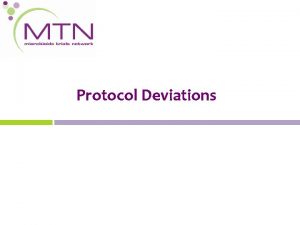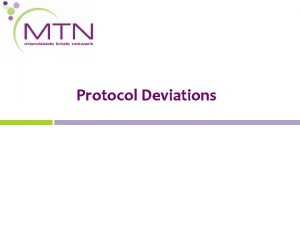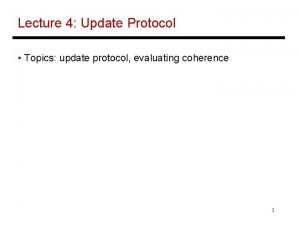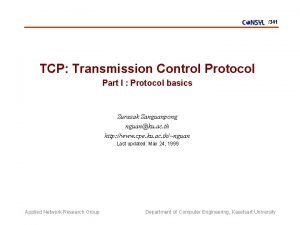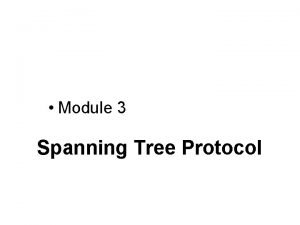Study design Study design is the protocol for
































- Slides: 32

Study design

�Study design : is the protocol for selecting persons to study and the method in which data are collected �The type of we choose is influenced by : - The purpose - The cost - Nature of the problem

Types of studies �Observational studies: � 1 - descriptive studies � 2 - analytical studies: a) prospective cohort b) cross sectional c) case control Experimental studies : -randomized clinical trials -field trials

Descriptive studies �-usually undertaken when little is known of the epidemiology of the disease �Does not involve hypothesis testing �Concerned with observing the distribution of the disease 1 - time distribution 2 - place distribution 3 - person distribution

Analytical studies �They are used to test specific etiologic hypothesis �Analytical means analytic the cause

1 - prospective cohort studt �The investigator starts with a group of individuals apparently free of the disease �This group is divided into those exposed to a possible risk factor and those not exposed �Then is followed through time in order to determine the incidence rate among the exposal and the unexposed

� number of new cases in a group in a specified period of time � 1 - incidence (risk)= population at risk during that period 1000

incidence in exposed population �Relative risk = incidence in non exposed population RR of 1 indicates the incidence in exposed is equal to the incidence in non exposed RR > 1 indicates that the exposed individuals are at a greater risk than non exposed RR<1 indicates that the exposed individuals are at a lower risk than non exposed

�Attributable risk: it is the proportion of disease incidence which can be attributed to specific exposure �AR=(incidence in exposed group) –(incidence in non exposed group ) �The attributable risk percent = (incidence in exposed group) –(incidence in non exposed group ) 100 Incidence in exposed group

Advantages of cohort studies � 1 - they allow complete description of the individuals experience subsequent to exposure � 2 - they provide a clear temporal sequence of exposure and disease � 3 - they provide excellent opportunity to study rare exposures � 4 - they permit the assessment of multiple outcomes � 5 - they permit the direct estimation of the rate of health problem and the RR associated with the exposure of interest � 6 - less chance for bias � 7 - they provide more understandable information

Disadvantages of cohort studies � 1 - not suitable for rare diseases where large numbers of subjects are required � 2 - long term follow up may be necessary when the latency period for the outcome of interest is long � 3 - the most serious problem is attrition or loss of people from the sample during the course of the study � 4 - they are very time consuming and expensive

� 5 - the exposure status may change during the conduct of the study � 6 - there may be attrition among the investigators

Case control studies (retrospective studies) �They are efficient and common epidemiological studies �They depend on exposure history among cases and controls �They investigate the association of a disease condition with a risk factor by contrasting the exposure of a series of cases with the exposure of selected controls

1 -Selection of cases �In regard to : - Histologic type - stage of disease - Date of diagnosis - Geographic location

2 -Selection of controls �To obtain estimates of the frequency of attribute or risk factor for comparison with its frequecy among cases �The comparison group may be: 1 - a probability sample of a defined population 2 - a sample of patients admitted to the same institution as cases 3 - a sample of relatives of the cases

matching �it is the process by which we select controls in such a way that they are similar to cases with regards to certain selected pertinent variables (eg. Age) which are known to influence the outcome of disease

The advantages of multiple controls � 1 - if the frequency of the risk factor does not differ from one control group to another , this increase internal consistency of the disese this is equivalent of conducting two studies 2 - if one control group is taken , and it happens that this disease is independently associated to the risk factor , the difference in the frequency of the factor between cases and controls may well be masked 3 - multiple controls also provide a check on bias

3 - collection of data �This is done through interviews , questionnairs or examination of records �The following precaution should be taken 1 - observations should be objective or if obtained by survey method well standardized 2 -preferably the investigator should be kept blind as to who is in the case or control group 3 - the same procedure eg. Interviews should be used for all groups

The validity of case-control studies can be enhanced by : � 1 - cases are representative to all cases in particular setting � 2 - cases are similar to controls with respect to risk factors other than the study factor � 3 - multiple controls with consistent results � 4 - when the cases and controls are truly selected independently of the exposure status � 5 -when the source of bias are mitigated � 6 -if repeated studies in different settings confirm each other

� 7 - if a hybrid design of case control is nested in a cohort study � 8 - if it is possible to demonstrate a dose – response or a gradient relationship

Analysis of case control data �The association of an exposure and disease is measured in case control study by calculation of the odds ratio (OR) which is the ratio of odds of exposure among cases to the odds of exposure among controls �Odds: they are the ratio of the number of people in a group with an event to the number of people without the event

example �In a study of the association of administrating long acting bronchdilator in asthmatic patients and occurance of nocturnal attacks If in the cases group 10 had nocturnal attacks and 90 did not The odds = 10 90 or 0. 11 Also if in the control group , 40 had nocturnal attacks and 60 did not The odds = 40 60 or 0. 67

Odds ratio (OR) �The ratio of the odds of an event in the cases group to the odds of the event in the control group �In the previous example , OR=0. 11 0. 67 =0. 16 cases with exposure controls without. exposure �So odds ratio= controls with exposure cases with. . exposure

�The odds ratio is a measure of relationship between exposure and disease 1 �If OR>1 �If OR= the exposure is not related to disease the exposure is positively related to disease 1 �If OR< the exposure is negatively related to disease the odds ratio is a good estimate of the relative risk in case con

Advantages of case control studies � 1 - it is the most frequent undertaken type of epidemiological studies � 2 - they are useful for studying health problems that occur infrequently � 3 - they are useful for studying health problems with a long latent interval � 4 -less time consuming and less expensive than cohort studies � 5 - they are useful for studying the effects of multiple risk factors on the health problems under study

� 6 - it requires a smaller sample than other studies � 7 -there is no problem of attrition � 8 - this is considered the earliest study provide leads to be followed up by more definitive cohort studies Disadvantages of case control studies: 1 - selection bias : because case and controls may be selected from two separete populations , it is difficult to be comparable

� 2 -Recall bias: exposure data are collected from records or by recall after the disease has occurred. Records may be incomplete and recall of past events is subject to human error � 3 -temporality is a serious problem , where it is not possible to determine whether risk led to the disease or vice versa � 4 - if the health problem is relatively common in the population (>5 -10%) the odds ratio is not a reliable estimate of the relative risk � 5 - they can not be used to determine the other possible health effects of an exposure. they are concerned with only one outcome

Types of bias � 1 - selection bias � 2 - recall bias � 3 - detection bias � 4 - observer bias

Retrospective studies Prospective studies 1 - require relatively short time 2 -Less expensive Longer time is required 3 -Suitable for rare diseases Suitable for rare exposures 4 -More liable for selection bias Less liable for selection bias 5 -Recall bias No recall bias 6 -No problem of attrition Attrition is a big problem 7 -Can not determine incidence 8 -The relative risk is estimated Incidence is determined Very costy The relative risk is accurately determined

Cross sectional studies (prevalence studies) �In cross sectional study exposure status and disease status are measured at one point in time �Prevalence rates among those with and without the exposure are determined and then compared �Their use is mainly for prevalence determination rather than for etiological investigation �The study tells us about distribution of a disease in the community rather than its etiology

Advantages of cross sectional studies � 1 -generalization of the results from the sample to the population as they often based on a sample of the general population � 2 -they are short term studies and less costy than prospective studies � 3 -it is used for administrative purposes � 4 - it is possible to make risk statement on bases of cross sectional studies for further studies

Disadvantages of cross sectional studies �It is difficult to separate cause and effect because measurement of exposure and disease are made at one point of time and it is impossible to determine which came first
 Fspos vägledning för kontinuitetshantering
Fspos vägledning för kontinuitetshantering Typiska drag för en novell
Typiska drag för en novell Nationell inriktning för artificiell intelligens
Nationell inriktning för artificiell intelligens Ekologiskt fotavtryck
Ekologiskt fotavtryck Varför kallas perioden 1918-1939 för mellankrigstiden
Varför kallas perioden 1918-1939 för mellankrigstiden En lathund för arbete med kontinuitetshantering
En lathund för arbete med kontinuitetshantering Personalliggare bygg undantag
Personalliggare bygg undantag Tidbok för yrkesförare
Tidbok för yrkesförare A gastrica
A gastrica Densitet vatten
Densitet vatten Datorkunskap för nybörjare
Datorkunskap för nybörjare Tack för att ni lyssnade bild
Tack för att ni lyssnade bild Hur skriver man en debattartikel
Hur skriver man en debattartikel Delegerande ledarstil
Delegerande ledarstil Nyckelkompetenser för livslångt lärande
Nyckelkompetenser för livslångt lärande Påbyggnader för flakfordon
Påbyggnader för flakfordon Arkimedes princip formel
Arkimedes princip formel Offentlig förvaltning
Offentlig förvaltning Bo bergman jag fryser om dina händer
Bo bergman jag fryser om dina händer Presentera för publik crossboss
Presentera för publik crossboss Jiddisch
Jiddisch Kanaans land
Kanaans land Klassificeringsstruktur för kommunala verksamheter
Klassificeringsstruktur för kommunala verksamheter Epiteltyper
Epiteltyper Claes martinsson
Claes martinsson Cks
Cks Lågenergihus nyproduktion
Lågenergihus nyproduktion Mat för idrottare
Mat för idrottare Verktyg för automatisering av utbetalningar
Verktyg för automatisering av utbetalningar Rutin för avvikelsehantering
Rutin för avvikelsehantering Smärtskolan kunskap för livet
Smärtskolan kunskap för livet Ministerstyre för och nackdelar
Ministerstyre för och nackdelar Tack för att ni har lyssnat
Tack för att ni har lyssnat





































